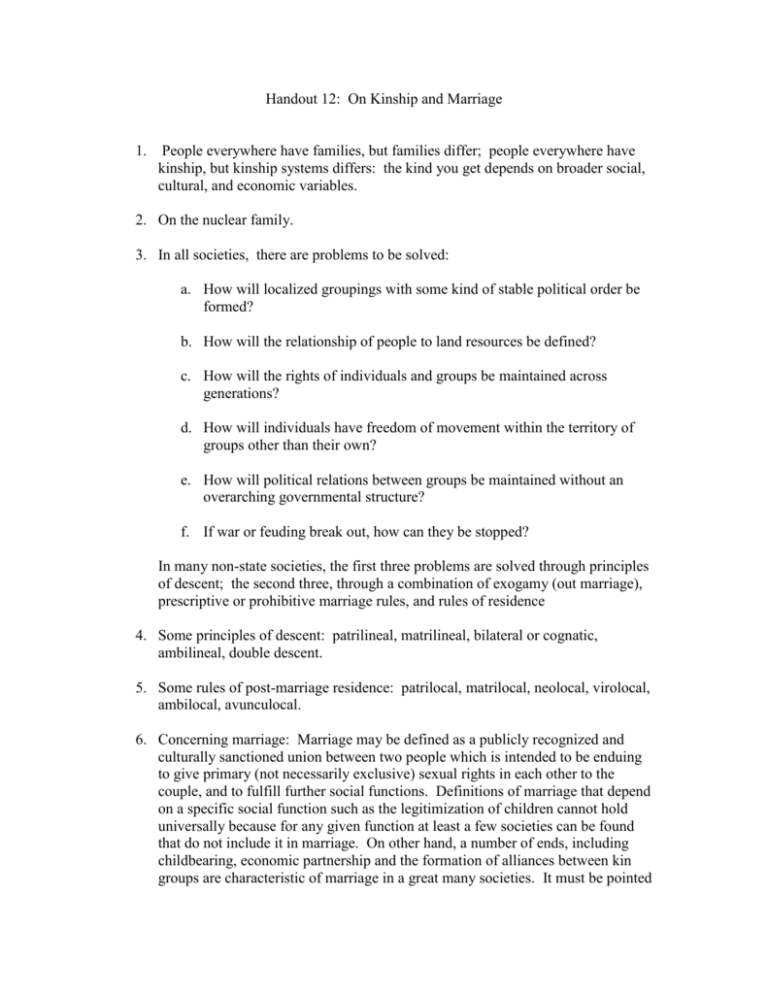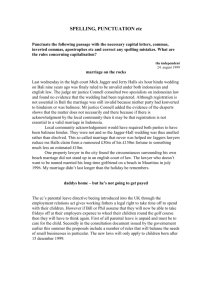
Handout 12: On Kinship and Marriage
1.
People everywhere have families, but families differ; people everywhere have
kinship, but kinship systems differs: the kind you get depends on broader social,
cultural, and economic variables.
2. On the nuclear family.
3. In all societies, there are problems to be solved:
a. How will localized groupings with some kind of stable political order be
formed?
b. How will the relationship of people to land resources be defined?
c. How will the rights of individuals and groups be maintained across
generations?
d. How will individuals have freedom of movement within the territory of
groups other than their own?
e. How will political relations between groups be maintained without an
overarching governmental structure?
f. If war or feuding break out, how can they be stopped?
In many non-state societies, the first three problems are solved through principles
of descent; the second three, through a combination of exogamy (out marriage),
prescriptive or prohibitive marriage rules, and rules of residence
4. Some principles of descent: patrilineal, matrilineal, bilateral or cognatic,
ambilineal, double descent.
5. Some rules of post-marriage residence: patrilocal, matrilocal, neolocal, virolocal,
ambilocal, avunculocal.
6. Concerning marriage: Marriage may be defined as a publicly recognized and
culturally sanctioned union between two people which is intended to be enduing
to give primary (not necessarily exclusive) sexual rights in each other to the
couple, and to fulfill further social functions. Definitions of marriage that depend
on a specific social function such as the legitimization of children cannot hold
universally because for any given function at least a few societies can be found
that do not include it in marriage. On other hand, a number of ends, including
childbearing, economic partnership and the formation of alliances between kin
groups are characteristic of marriage in a great many societies. It must be pointed
out that there are societies that allow people to marry a member of his or her own
sex, or even a ghost to a spirit. Moreover there are societies where several people
of one sex act as an individual. Probably no definition, however stretched and
qualified, can encompass all societies and all the relationships that have been
called marriage.
7. Some examples of different marriages/families:
a. The Nuer of the Sudan: Among these pastoralists, a widow remarries her dead
husband’s close relative, but their children are legally considered to be
fathered by the dead first husband. This arrangement is called “ghost
marriage”. Another arrangement acceptable to the Nuer involves marriage
between an elderly woman of sufficient means and a young girl. The girl takes
lovers, and any children she bears are considered legally to be fathered by the
elderly woman.
b. The Nayar of South India: Among these Hindus, a girl must be ritually
married before her first menstruation. However, when she matures, she takes
lovers as nocturnal visitors into the household she shares with her brothers and
close matrilineal kin. The lovers must be socially recognized and approved by
the men of the household, and they must formally acknowledge their paternity
or possible paternity (a woman may have several lovers at once) of the child.
c. The Okrika Ijo of the Nile Delta: These people have two forms of marriage. In
the first, the husband and his kin make a large payment of cattle to the wife’s
guardian. In the second, they make only a small payment. In the first case, the
husband acquires proprietary rights over the wife and the children she bears
by him. In the latter he acquires rights of sexual access, but her guardian
retains legal rights over her and her children.
d. Toda of India: Among these people, a group of men have a single wife.
Fatherhood is legally defined by ritual presentation of a bow by each of the
husbands in sequence. The father of the child is the one who last presented the
bow, even if he has since died.
e. Mut‘a marriage in the Middle East: Mut’a marriage in the Muslim Middle
East is a contractual arrangement whereby a woman accompanies a man
during a legally specified period while the man is making a pilgrimage or
some other lengthy trip. The man pays the “wife” for her sexual services; but
this is not simply a form of contractual prostitution, since children she bears
from their marriage are considered to be among his legitimate heirs.
f. Homosexual marriage in western Egypt: In the Siwah Oasis of western Egypt,
all men and boys engage in homosexual relations. Homosexuality is openly
discussed and socially approved. Until recently, marriages between men and
boys were legally possible and were celebrated with great pomp; the marriage
payments for a boy were sometimes as much as 15 times as great as the fixed
payment for a woman.
8. On the Mundurucu









